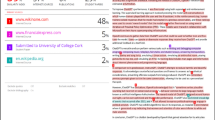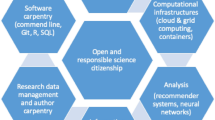Abstract
The future of Western universities as public institutions is the subject of extensive continuing debate, underpinned by the issue of what constitutes valid knowledge. Where in the past only propositional knowledge codified by academics was considered valid, in the new economy enabled by information and communications technology, the procedural knowledge of expertise has become a key commodity, and the acquisition of this expertise is increasingly seen as a priority by intending university students. Universities have traditionally proved adaptable to changing circumstances, but there is little evidence to date of their success in accommodating to the scale and unprecedented pace of change of the Knowledge Economy or to the new vocationally-oriented demands of their course clients. And in addition to these external factors, internal ones are now at work. Recent developments in eLearning have enabled the infiltration of commercial providers who are cherry-picking the most lucrative subject areas. The prospect is of a fracturing higher education system, with the less adaptable universities consigned to a shrinking public-funded sector supporting less vocationally saleable courses, and the more enterprising universities developing commercial partnerships in eLearning and knowledge transfer. This paper analyses pressures upon universities, their attempts to adapt to changing circumstances, and the institutional transformations which may result. It is concluded that a diversity of partnerships will emerge for the capture and transfer of knowledge, combining expertise from the economy with the conceptual frameworks of the academy.
Similar content being viewed by others
References
Bargh, C., Scott, P., & Smith, D. (1996). Governing universities. Changing the culture? Bury St. Edmunds: SRHE and Open University Press.
Barnett, R. (2000). University knowledge in an age of supercomplexity. Higher Education, 40(4), 409–422.
Bayliss, V. (2003). Redefining work 2. London: The Royal Society for the encouragement of Arts, Manufactures and Commerce.
BBC. (2006). GCSE Bitesize Revision website, British Broadcasting Corporation. Available at: http://www.bbc.co.uk/schools/gcsebitesize/mobile/ (18 December 2006).
Bekhradnia, B. (2006). Demand for higher education to 2020. London: Higher Education Policy Institute.
Berners-Lee, T., Hendler, J., & Lassila, O. (2001). The semantic web. Scientific American, 284(5), 34–53.
Booth, C., Bowie, S., Jordan, J., & Rippin, A. (2000). The use of the case method in large and diverse undergraduate business programmes: Problems and issues. The International Journal of Management Education, 1(1).
Boyd, J. (2005). A cellphone is the only gadget you’ll ever need. New Scientist, No. 2489, 5 March.
Campbell, G. (2005). There’s something in the air: Podcasting in education, EDUCAUSE Review (40) November/December. Available at: http://www.educause.edu/apps/er/index.asp (18 December 2006).
Carlson, S., & Carnevale, D. (2001). Debating the demise of NYUonline: Did the venture go under because of the changing economy or bad decisions? The Chronicle of Higher Education: Information Technology, 14 December. Available at: http://www.chronicle.com/free/v48/i16/16a03101.htm (18 December 2006).
Castells, M. (1997). End of millennium, volume three of the information age: Economy, society and culture. Oxford: Blackwell.
CETIS. (2006). Centre for educational technology interoperability standards website. Available at: http://www.cetis.ac.uk (18 December 2006).
Cunningham, S., Tapsall, S., Ryan, Y., Stedman, L., Bagdon, K., & Flew, T. (1998). New media and borderless education: A review of the convergence between global media networks and higher education provision. Evaluations and Investigations Programme, Higher Education Division, Department of Education, Training and Youth Affairs, Australia. Available at: http://www.dest.gov.au/sectors/higher_education/publications_resources/profiles/archives/new_media_and_borederless_education.htm (18 December 2006).
Cowan, J., George, J., & Pinheiro-Torres, A. (2004). Alignment of developments in higher education. Higher Education, 48(4), 439–459.
Davenport, T., & Prusak, L. (1998). Working knowledge: How organizations manage what they know. Harvard: Harvard Business School Press.
DEC. (2006). Doncaster education city, Doncaster College, England. Available at: http://www.don.ac.uk/default.aspx? page=39 (18 December 2006).
Delanty, G. (2001). Challenging knowledge: The university in the knowledge society. Buckingham: SRHE/Open University.
Ducatel, K. (1998). Learning and skills in the knowledge economy. DRUID Working Paper No. 98-2, Danish Research Institute for Industrial Dynamics, Aalborg University. Available at: http://www.druid.dk/wp/pdf_files/98-2.pdf (18 December 2006).
Eckel, P., Green, M., & Affolter-Caine, B. (2004). Curricular joint ventures: A new chapter in US cross-border education? Policy Futures in Education, 2(2), 299–315.
Evans, P. (1997). The eclipse of the state? Reflections on stateness in an era of globalization. World Politics, 50(1), 62–87.
Fathom (2003). Fathom Archive, Columbia University. Available at: http://www.fathom.com (18 December 2006).
Friedman, T. (2005). The world is flat: The globalised world in the twenty-first century. London: Penguin Books.
Garrison, D., & Kanuka, H. (2004). Blended learning: Uncovering its transformative potential in higher education. The Internet and Higher Education, 7(2), 95–105.
Gibbons, M., Limoges, C., Nowotny, H., Scott P., Schwartzman, S., & Trow, M. (1994). The new production of knowledge—the dynamics of science and research in contemporary societies. London: Sage.
Green, A. (1997). Education, globalization and the nation state. New York: St. Martin’s Press.
Heim, M. (1998). Virtual realism. Oxford: University Press Inc USA.
IMCA.(2006). Association of international management centres online campus. Available at: http://www.i-m-c.org/imc/ (18 December 2006).
Jarvis, P. (2001). Universities and corporate universities: The higher learning industry in global society. London: Kogan Page.
JORUM. (2006). JISC online repository for learning and teaching materials, Joint Information Systems Committee. Available at: http://www.jorum.ac.uk (18 December 2006).
Kelly, T. (1952). The origin of mechanics’ institutes. British Journal of Educational Studies, 1(1), 17–27.
Lankshear, C., Peters, M., & Knobel, M. (2002). Information, knowledge and learning, In M. Lea, & K. Nicoll (Eds.), Distributed learning: Social and cultural approaches to practice. London: RoutledgeFalmer.
Lave, J., & Wenger, E. (1991). Situated learning. Legitimate peripheral participation. Cambridge, UK: University of Cambridge Press.
Leinhardt, G., McCarthy Young, K., & Merriman, J. (1995). Integrating professional knowledge: The theory of practice and the practice of theory. Learning and Instruction, 5(4), 401–408.
Littlejohn, A. (2003). Reusing online resources: A sustainable approach to e-learning. London: Kogan Page.
LSC. (2006). Work based learning, learning and skills council (UK) website. Available at: http://www.lsc.gov.uk/National/Documents/SubjectListing/FundingLearning/WorkBasedLearning/default.htm (18 December 2006).
LSN. (2006). E-learning and technology, learning and skills network (UK) website. Available at: http://www.lsneducation.org.uk/programmes/portal.aspx?ProgID=5 (18 December 2006).
May, C. (2002). The information society: A sceptical view. Cambridge, UK: Polity Press.
MERLOT. (2006). Multimedia educational resource for learning and online teaching. Available at: http://www.merlot.org (18 December 2006).
Moe, M., Bailey, K., & Lau, R. (1999). The book of knowledge: Investing in the growing education and training industry. San Francisco: Global Securities Research and Economic Group, and Global Fundamental Equity Research Department, Merrill Lynch and Co.
Morey, A. (2004). Globalization and the emergence of for-profit higher education. Higher Education, 48(1), 131–150.
Moran, L., & Myringer, B. (1999). Flexible learning and university change. In K. Harry (Ed.), Higher education through open and distance learning: World review of distance education and open learning—Volume I. London: Routledge.
Nguyen, F. (2004). Killing two birds with one stone: Creating EPSS through eLearning. Arizona State University/Intel Corporation, reproduced on the American Society for Training & Development website. Available at: http://www.astd.org/NR/rdonlyres/8F40492E-4850–4F5A-B74B-0D3C25C4BF61/5840/W206forWeb.pdf (18 December 2006).
NMC/EDUCAUSE. (2006). Horizon report, joint publication of the New Media Consortium (NMC) and EDUCAUSE. Available at: http://www.educause.edu/ir/library/pdf/CSD4387.pdf (18 December 2006).
Pankratius, V., Sandel, O., & Stucky, W. (2004). Retrieving content with agents in Web-service e-learning systems. IFIP Symposium on Professional Practice in AI. Germany: Institute of Applied Informatics and Formal Description Methods, University of Karlsruhe. Available at: http://www.aifb.uni-karlsruhe.de/BIK/vpa/109.pdf (18 December 2006).
Paris, M. (2003). Simulation authoring tools for interactive e-learning courseware development, Higher Education Academy Resources database. Available at: http://www.heacademy.ac.uk/resources.asp?process=full_record§ion=generic&id=451 (18 December 2006).
Petras, J., & Veltmeyer, H. (2001). Globalization unmasked: The new face of imperialism. London: Zed.
Polanyi, M. (1958). Personal knowledge: Towards a post-critical philosophy. London: Routledge and Kegan Paul.
Porat, M., & Rubin, M. (1977). The information economy (9 volumes). Office of Telecommunications Special Publication 77–12. Washington DC, US: Department of Commerce.
Poster, M. (1995). The second media age. Cambridge: Polity Press.
Prensky, M. (2001). Digital natives, digital immigrants, On the Horizon 9(5). NCB University Press, October.
Prosser, M., & Trigwell, K. (1999). Understanding learning and teaching: The experience in higher education. Buckingham: SRHE/Open University.
Readings, B. (1996). The university in ruins. Cambridge, USA: Harvard University Press.
Reich, R. (1991). The work of nations. New York: Vintage Books.
RSA. (1999). Opening minds: Education for the 21st Century. London: The Royal Society for the encouragement of Arts, Manufactures and Commerce.
Savin-Baden, M. (2003). Facilitating problem-based learning in higher education: Illuminating perspectives. Maidenhead: SRHE/Open University.
Schön, D. (1983). The reflective practitioner: How professionals think in action. New York: Basic Books.
Scott, P. (2002). The future of general education in mass higher education systems. Higher Education Policy, 15, 61–75.
Stanford (2006). Stanford on iTunes U website, Stanford University. Available at: http://www.itunes.stanford.edu/ (18 December 2006).
Tigelaar, D., Dolmans, D., Wolfhagen, I., & van der Vleuten, C. (2004). The development and validation of a framework for teaching competencies in higher education. Higher Education, 48(2), 253–268.
Turkle, S. (1997). Life on the screen: Identity in the age of the internet. New York: Touchstone.
Tynjälä, P., Välimaa, J., & Sarja, A. (2003). Pedagogical perspectives on the relationships between higher education and working life. Higher Education, 46(2), 147–166.
UoP. (2006). University of Phoenix website. Available at: http://www.phoenix.edu/ (18 December 2006).
Välimaa, J. (1999). Managing a diverse system of higher education. In M. Henkel & B. Little (Eds.), Changing relationship between higher education and the state. London and Philadelphia: Jessica Kingsley Publishers.
Välimaa, J. (Ed.). (2001). Finnish higher education in transition. Perspectives on massification and globalisation. Institute for Educational Research, University of Jyväskylä, Finland.
Waks, L. (2004). In the shadow of the ruins: Globalization and the rise of corporate universities. Policy Futures in Education, 2(2), 278–298.
Wikipedia (2006). Wikipedia, the free encyclopedia. Available at: http://www.en.wikipedia.org/ (18 December 2006).
Zemsky, R., & Massy, W. (2004) Thwarted innovation: What happened to e-learning and why. A learning alliance report, University of Pennsylvania. Available at: http://www.irhe.upenn.edu/Docs/Jun2004/ThwartedInnovation.pdf (18 December 2006).
Author information
Authors and Affiliations
Corresponding author
Rights and permissions
About this article
Cite this article
Williams, P.J. Valid knowledge: the economy and the academy. High Educ 54, 511–523 (2007). https://doi.org/10.1007/s10734-007-9051-y
Received:
Accepted:
Published:
Issue Date:
DOI: https://doi.org/10.1007/s10734-007-9051-y




